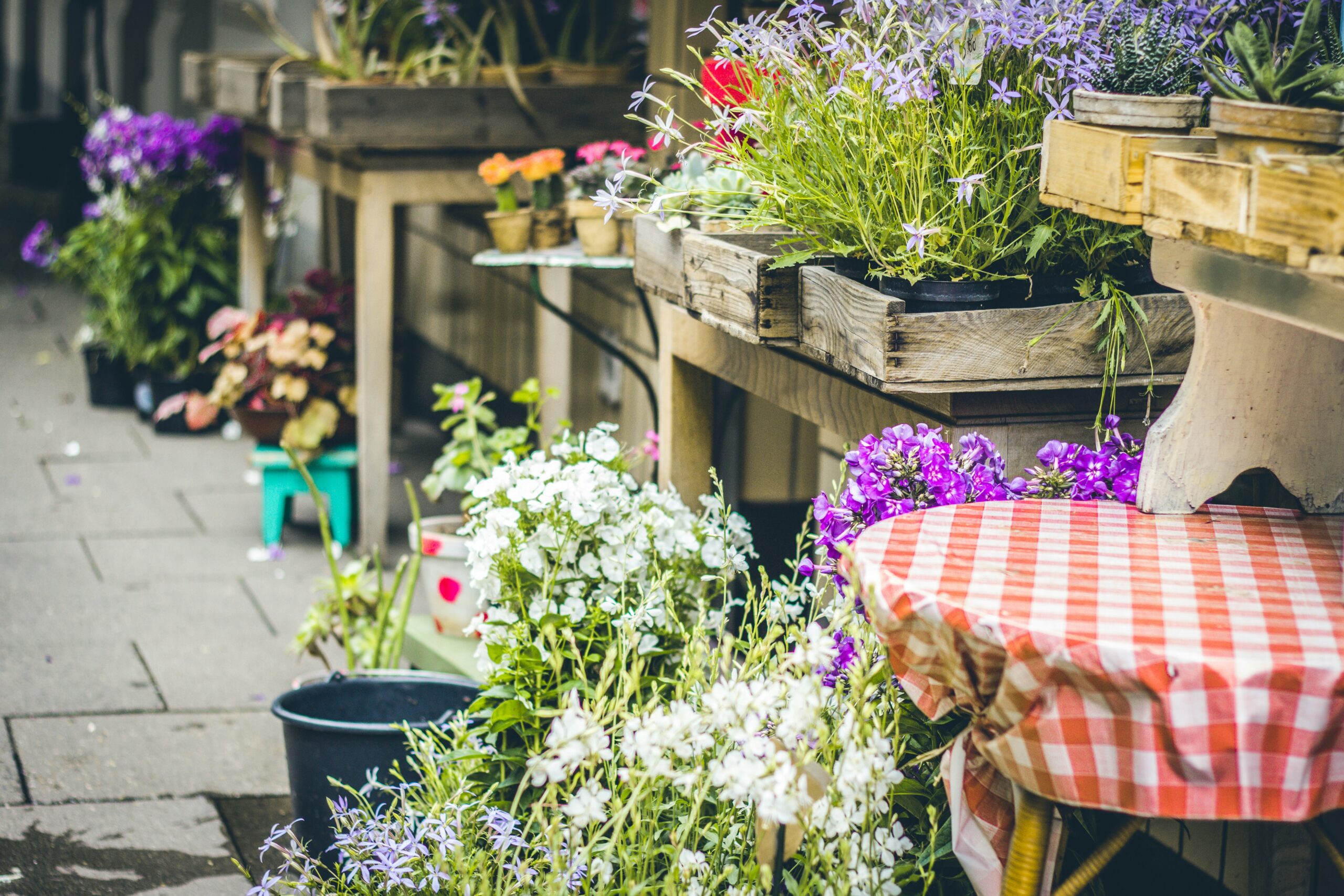
Wow, did you know that temperatures in Florida can soar up to 100°F during peak summer? That’s hot enough to fry an egg on the sidewalk! But don’t let the heat wilt your gardening dreams. As a passionate Florida gardener, I’ve discovered a secret weapon: heat-tolerant container plants.
These tough beauties laugh in the face of our scorching summers, turning even the most sun-baked patio into a lush, tropical paradise. Ready to beat the heat and create your own container garden oasis? Let’s dive into my top 15 picks for heat-tolerant plants that’ll thrive in your Florida containers!
Colorful Blooms: Heat-Tolerant Flowering Plants for Florida Containers
When it comes to Florida container gardening, choosing heat-tolerant plants that thrive in the intense sun is key. Luckily, there are plenty of flowering options that not only survive but flourish in Florida’s heat, adding vibrant color and life to your patio or garden. Here are five fantastic choices to consider:
Pentas: A Butterfly Magnet with Star-Shaped Clusters
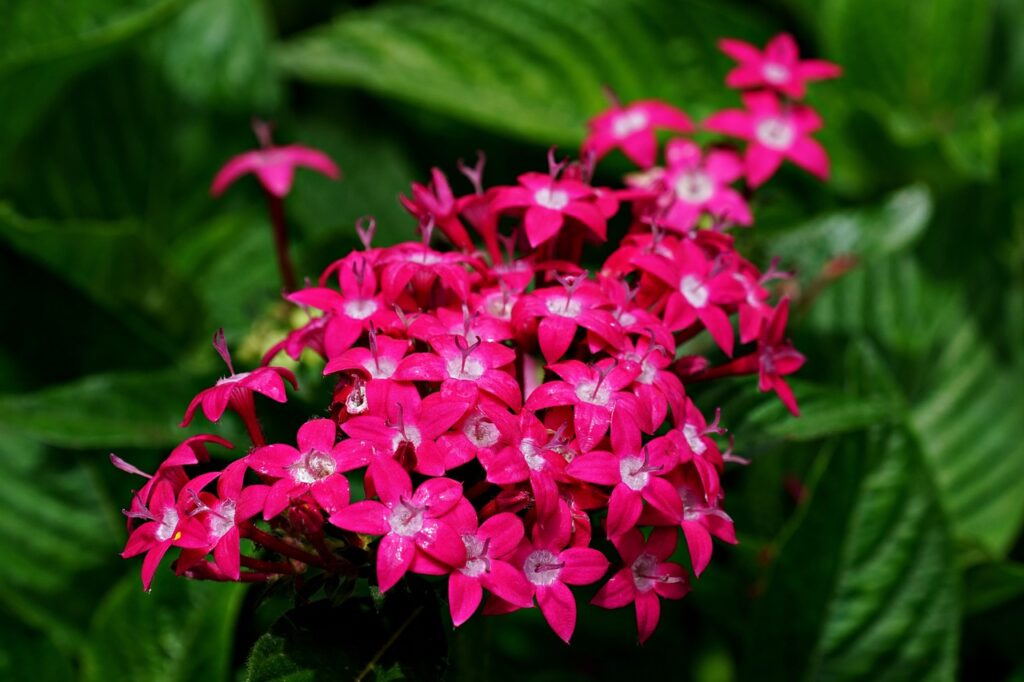
Pentas (Pentas lanceolata) are a go-to for Florida gardeners who want continuous color and wildlife-friendly plants. With their star-shaped clusters of pink, red, lavender, and white blooms, pentas are highly attractive to butterflies and hummingbirds.
These plants thrive in full sun and can tolerate the hottest summer days. Their long blooming season makes them perfect for container gardens, and they are relatively low-maintenance, needing only regular watering and deadheading to promote more blooms.
Gaillardia (Blanket Flower): Drought-Tolerant with Daisy-Like Blooms
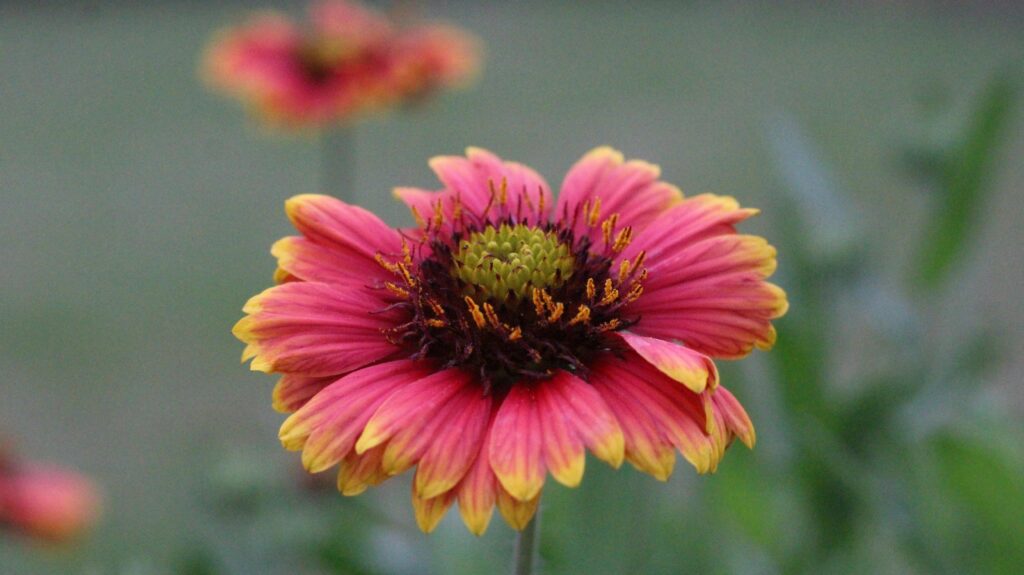
Gaillardia, commonly known as blanket flower, offers striking daisy-like flowers in shades of red, orange, and yellow. This hardy perennial is drought-tolerant once established and can withstand Florida’s sandy soils and heat, making it an ideal choice for containers.
With regular deadheading, Gaillardia blooms continuously throughout the summer and into fall. Its vibrant colors and ability to attract pollinators make it a must-have for adding some bold color to your Florida garden.
Lantana: Low-Maintenance with Multicolored Flower Clusters
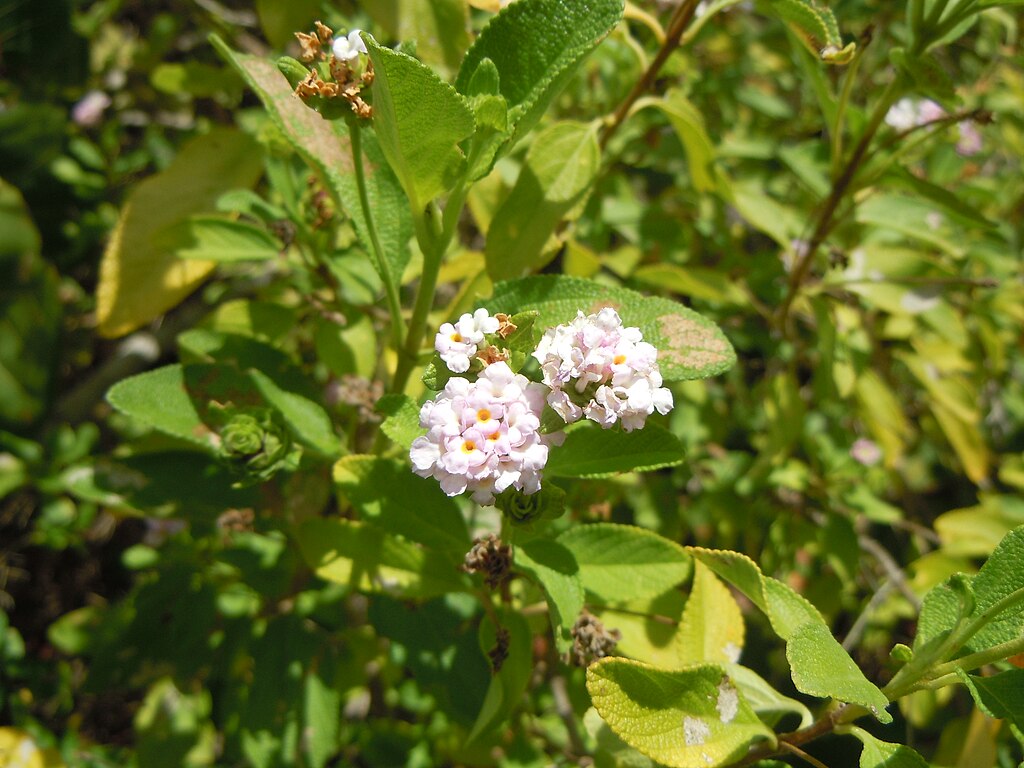
Lantana is a tough, low-maintenance flowering plant that can handle just about anything Florida throws at it—intense sun, heat, humidity, and even occasional drought.
Known for its clusters of small, multicolored flowers, lantana provides bright splashes of color in shades of orange, pink, yellow, and purple. It’s perfect for containers, especially since it requires very little watering once established. Bonus: it’s a favorite for pollinators, particularly butterflies!
Look for the native variety at nurseries near you.
Purslane: Succulent-Like Leaves with Vibrant Flowers
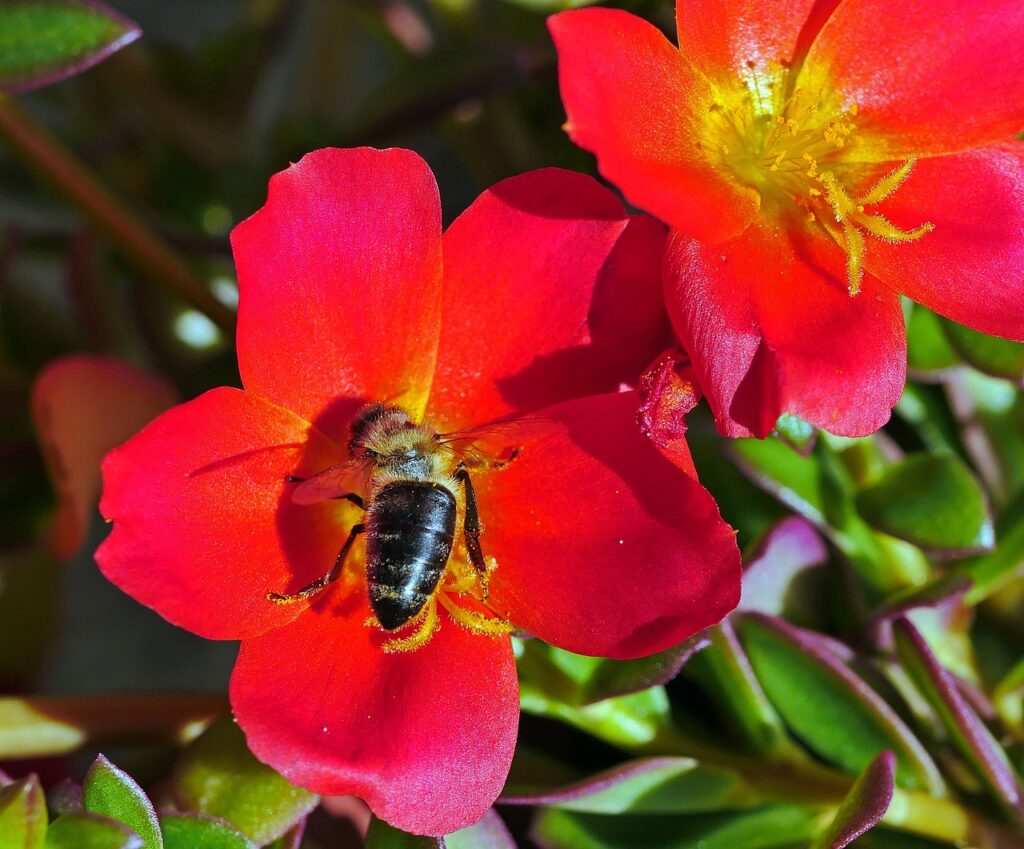
Purslane is an excellent choice for Florida gardeners looking for a heat-tolerant plant that combines the hardiness of succulents with beautiful, vibrant blooms. This trailing plant features fleshy, succulent-like leaves and produces bright, jewel-toned flowers in pink, yellow, red, and orange.
Purslane thrives in full sun and can tolerate poor soils, making it ideal for containers where other plants might struggle. Its low water needs make it especially well-suited for Florida’s hot summers, and it looks stunning spilling over the sides of pots or hanging baskets.
Angelonia (Summer Snapdragon): Vertical Spikes of Delicate Blossoms
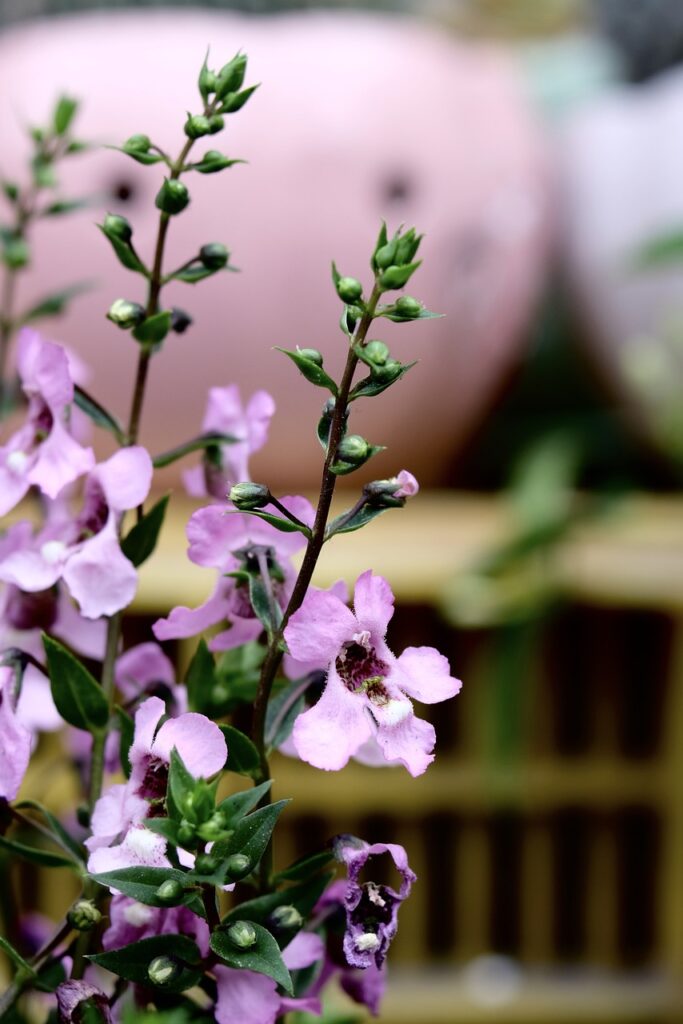
If you’re looking to add vertical interest to your container garden, Angelonia—also known as summer snapdragon—is a fantastic option. This heat-tolerant annual (or perennial in some parts of Florida) produces tall spikes covered in small, delicate flowers in shades of purple, pink, white, and blue.
Angelonia thrives in full sun and blooms all summer long, even in Florida’s hottest months. Its upright growth habit makes it perfect for mixing with lower-growing plants in containers to create depth and dimension.
These colorful, heat-tolerant flowering plants are perfect for brightening up your Florida container garden. With their resilience to heat and humidity, they’ll keep your space looking vibrant and beautiful all summer long.
Lush Foliage: Heat-Resistant Leafy Plants for Shade and Texture
While colorful blooms are fantastic for any container garden, lush foliage can add depth and texture, particularly in shaded areas.
If you’re looking for heat-resistant leafy plants to elevate your Florida container garden, consider these five stunning options that bring vibrant colors and unique shapes:
Coleus: Vibrant Foliage in a Rainbow of Colors
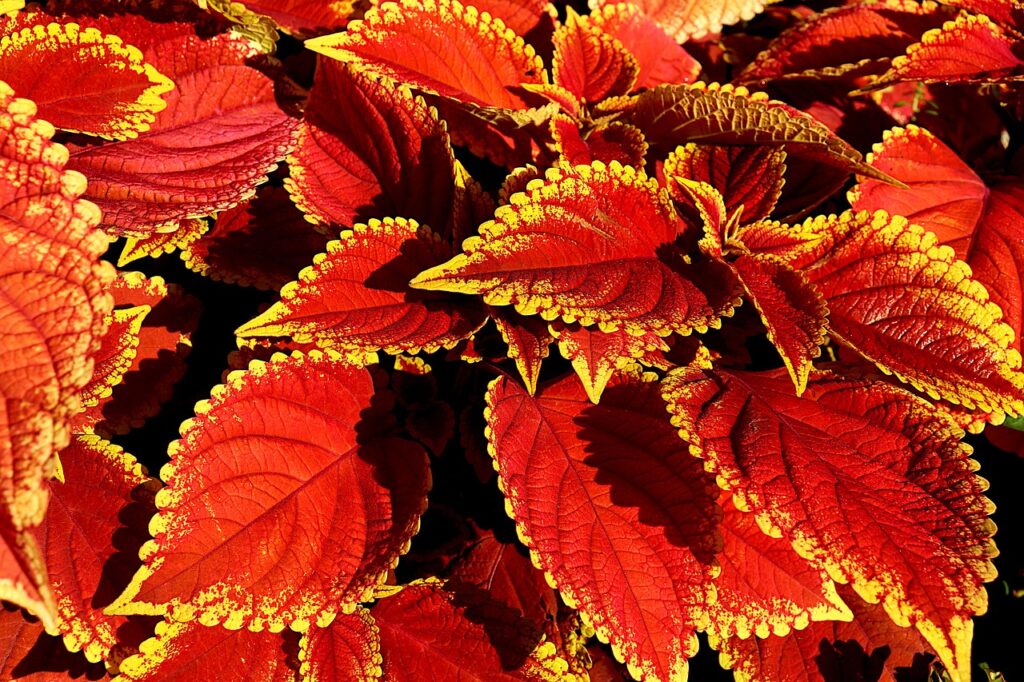
Coleus (Solenostemon scutellarioides) is a fantastic choice for adding bold, vibrant color to your container garden. Available in a stunning array of shades—think deep reds, bright greens, and striking yellows—these plants thrive in partial shade, making them perfect for brightening up shadier spots on your patio.
Coleus is also quite versatile; it can be used as a centerpiece in larger pots or as a border plant in mixed arrangements. Just be sure to keep their soil consistently moist, and you’ll enjoy their colorful foliage all summer long.
Caladium: Heart-Shaped Leaves Perfect for Shady Spots
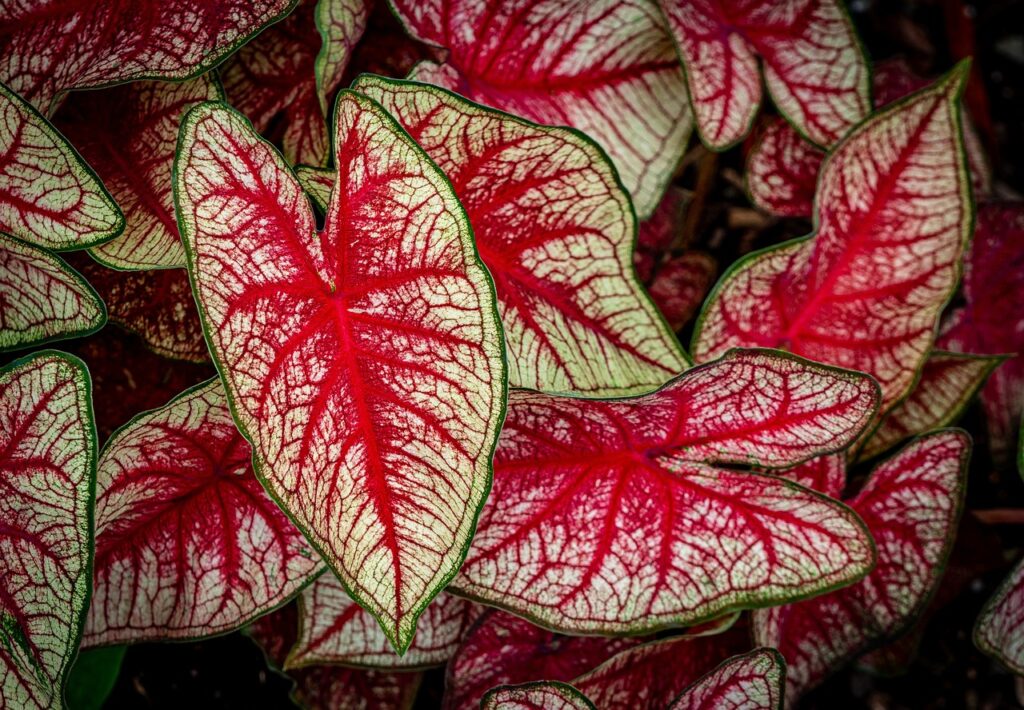
Caladiums are beloved for their heart-shaped leaves and stunning variegated patterns. These tropical perennials thrive in the shade and are an excellent choice for adding a splash of color to your container garden without direct sunlight.
Available in various shades of green, pink, red, and white, caladiums can create a striking contrast when paired with darker foliage or brightly colored blooms. They prefer moist, well-drained soil and will flourish with regular watering, making them perfect for a shaded patio or garden corner.
Silver Buttonwood: Silvery Foliage for a Coastal Vibe
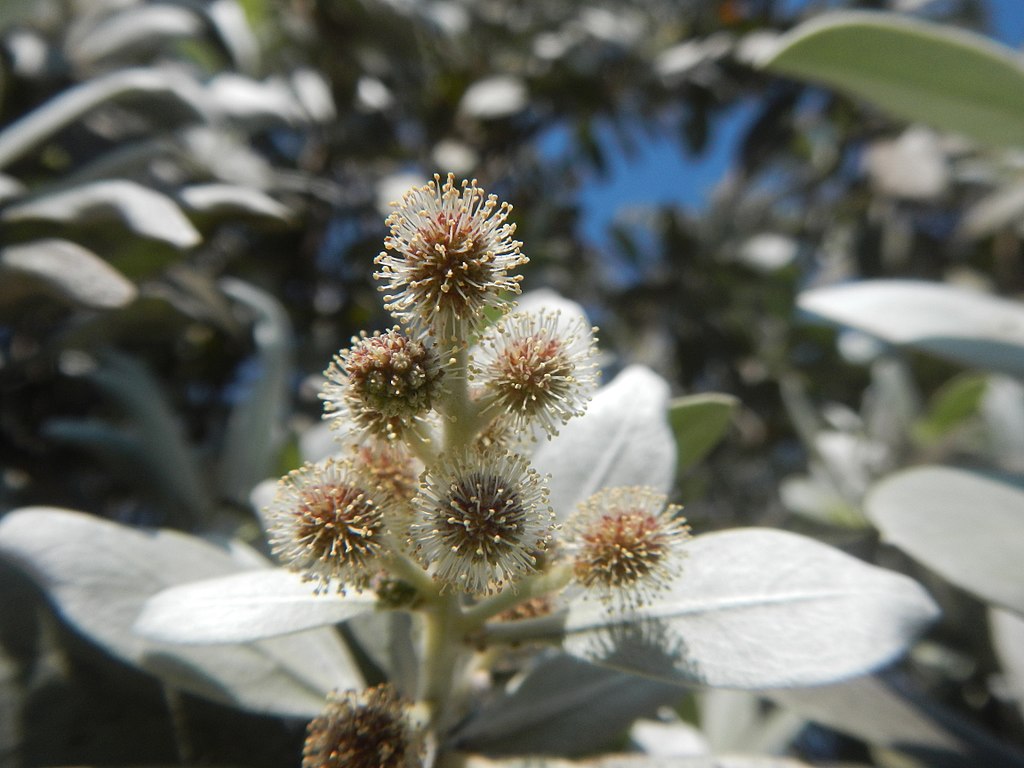
For a touch of coastal charm, consider the Silver Buttonwood (Conocarpus erectus). This hardy shrub features attractive silvery-green leaves that can add a unique texture to your container arrangements. Silver Buttonwood is not only drought-tolerant but also salt-tolerant, making it an excellent choice for coastal areas in Florida.
Whether used as a standalone plant or as a backdrop to colorful blooms, its distinctive foliage provides a beautiful contrast that enhances any garden design. Ensure it receives plenty of sunlight and water moderately for optimal growth.
Croton: Bold, Multicolored Leaves for a Tropical Feel
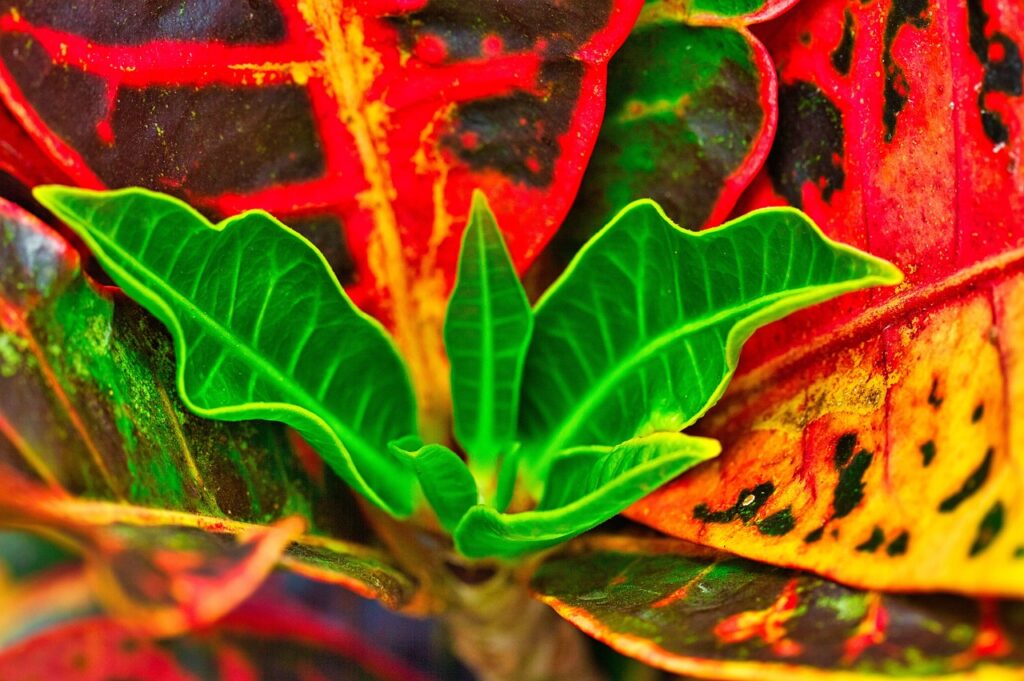
If you want to inject a tropical vibe into your container garden, look no further than Croton (Codiaeum variegatum). Known for its stunning, multicolored leaves in shades of yellow, red, and green, Croton can be a true showstopper.
These vibrant plants thrive in full sun and will appreciate well-drained soil. Crotons are perfect for larger containers, where their bold foliage can shine as a focal point. Keep the soil consistently moist (but not soggy), and prune occasionally to maintain a tidy appearance.
Ti Plant (Cordyline): Dramatic, Sword-Like Leaves in Various Hues
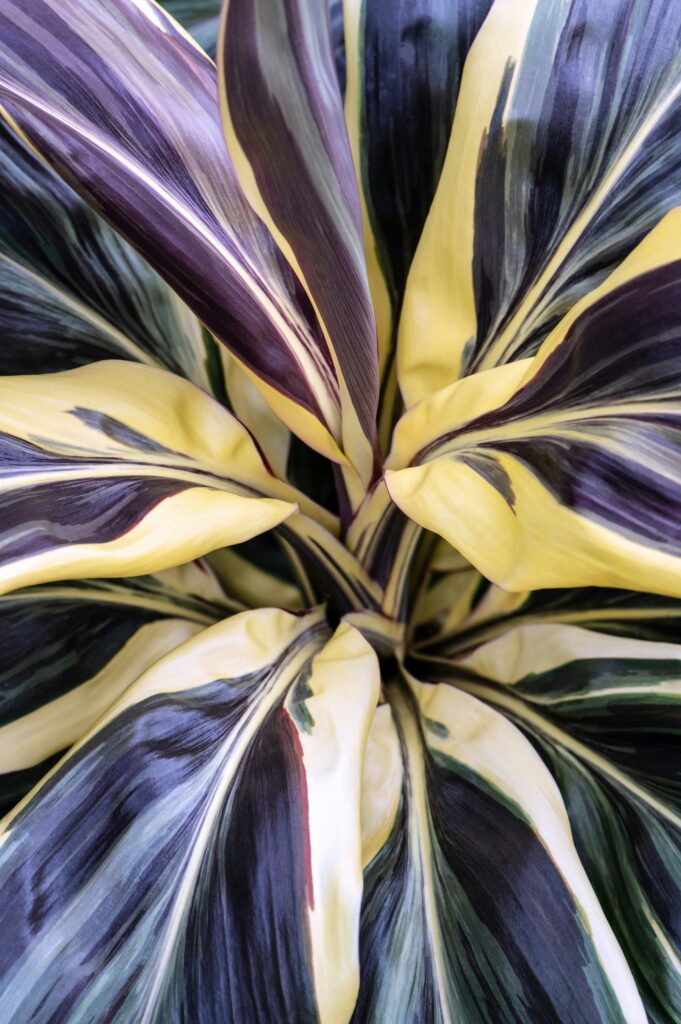
The Ti Plant, or Cordyline, is a stunning option for adding dramatic foliage to your container garden. With its long, sword-like leaves available in vibrant hues of green, red, and purple, this plant can serve as a striking centerpiece.
Ti Plants thrive in bright, indirect light, making them well-suited for patios with filtered sunlight. They prefer well-drained soil and benefit from regular watering, especially during dry spells. Incorporate them into mixed arrangements for a dramatic effect, or let them stand alone for a bold statement.
With these lush, heat-resistant leafy plants, you can create a beautiful and textured container garden that thrives in Florida’s unique climate. Their resilience to heat and humidity ensures your garden remains vibrant and inviting throughout the season.
Edible Delights: Heat-Tolerant Herbs and Vegetables for Container Gardens
If you’re looking to grow your own fresh produce while enjoying the beauty of container gardening, you’ll love these heat-tolerant herbs and vegetables.
Perfectly suited for Florida’s warm climate, these options will thrive in your garden while providing delicious flavors for your culinary creations.
Rosemary: Aromatic Herb That Loves the Heat
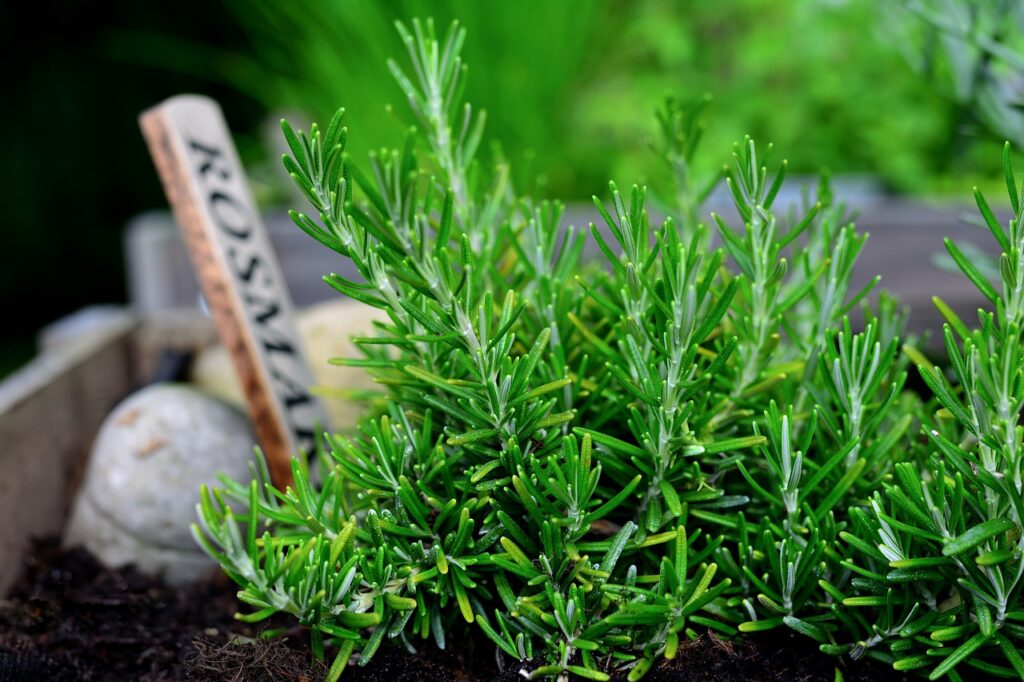
Rosemary (Rosmarinus officinalis) is a must-have herb for any Florida container garden. This hardy perennial thrives in the heat and full sun, making it an excellent choice for our warm climate. Not only does rosemary have a delightful aroma, but it’s also versatile in the kitchen—perfect for seasoning meats, vegetables, and even breads.
Plant rosemary in well-drained soil and water it moderately, allowing the soil to dry out between waterings. Regular pruning will encourage bushy growth and prevent the plant from becoming too woody.
Cuban Oregano: Succulent-Like Herb with a Strong Flavor

Cuban Oregano (Plectranthus amboinicus), also known as Spanish thyme, is a succulent-like herb that adds a punch of flavor to various dishes. This heat-loving plant thrives in full sun and well-drained soil, making it ideal for container gardening.
Cuban Oregano features thick, fleshy leaves that can be harvested year-round, providing a fresh supply of flavor for soups, stews, and marinades. Water it moderately, ensuring the soil dries out slightly between waterings. This herb also has lovely purple flowers, making it a beautiful addition to your garden.
Cherry Tomatoes: Compact Varieties Perfect for Containers
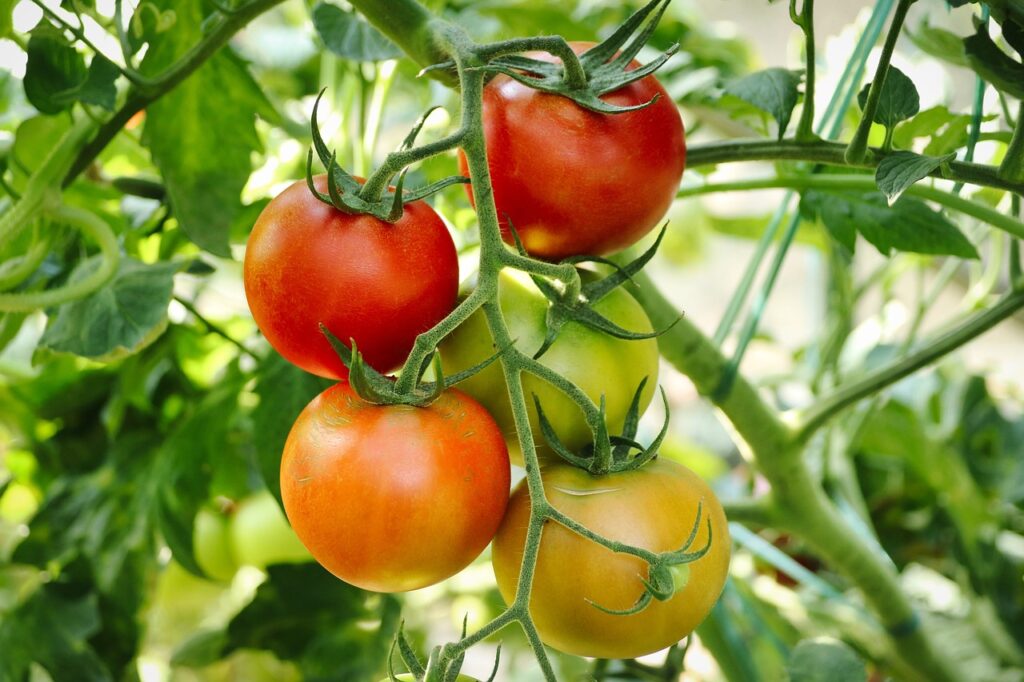
When it comes to container gardening, cherry tomatoes are a fantastic choice. Compact varieties, such as ‘Tiny Tim’ or ‘Tumbling Tom,’ are bred specifically for small spaces and can thrive in pots on your patio. These sweet, bite-sized tomatoes love the heat and will produce abundantly throughout the growing season.
Plant them in well-draining potting mix and provide support, like a small cage or stake, as they grow. Make sure to water them regularly, especially during dry spells, and consider fertilizing every few weeks to encourage healthy fruit production.
Hot Peppers: Thrive in Florida’s Heat and Add Spice to Your Garden
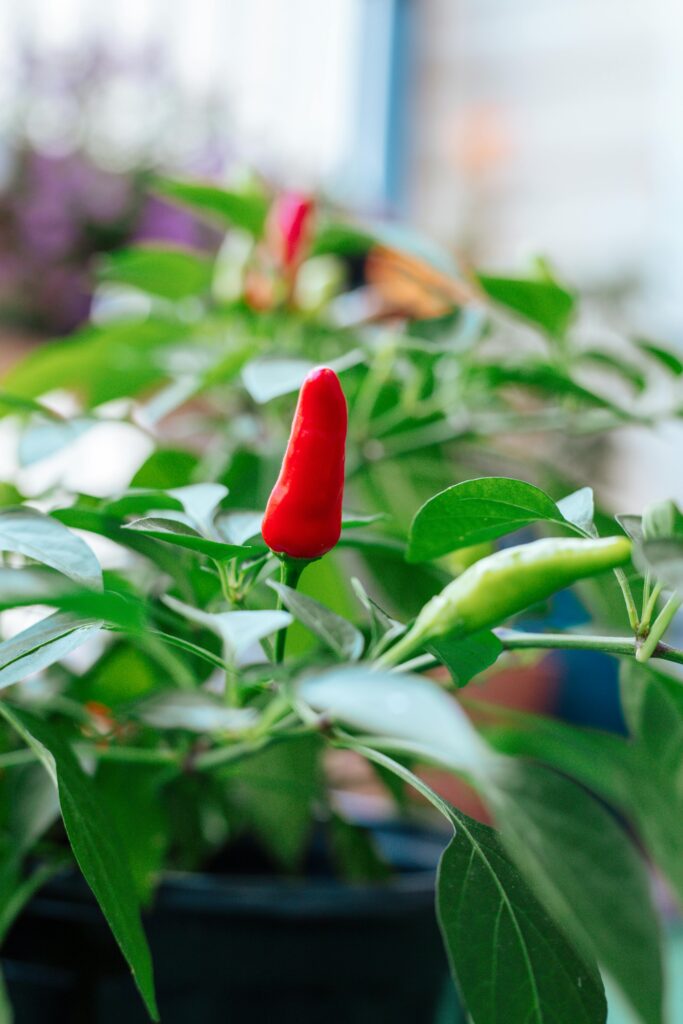
Hot peppers are another excellent option for container gardens in Florida. Varieties like jalapeños, habaneros, and cayennes flourish in the warm weather and add a delightful kick to your dishes. Plant your peppers in a sunny spot with well-drained soil, and they’ll reward you with a bountiful harvest.
Water consistently, keeping the soil moist but not soggy, and consider fertilizing with a balanced fertilizer every few weeks. With proper care, your peppers will produce a stunning array of colorful fruits that can be harvested throughout the season.
Eggplant: Stunning Purple Fruits and Attractive Foliage
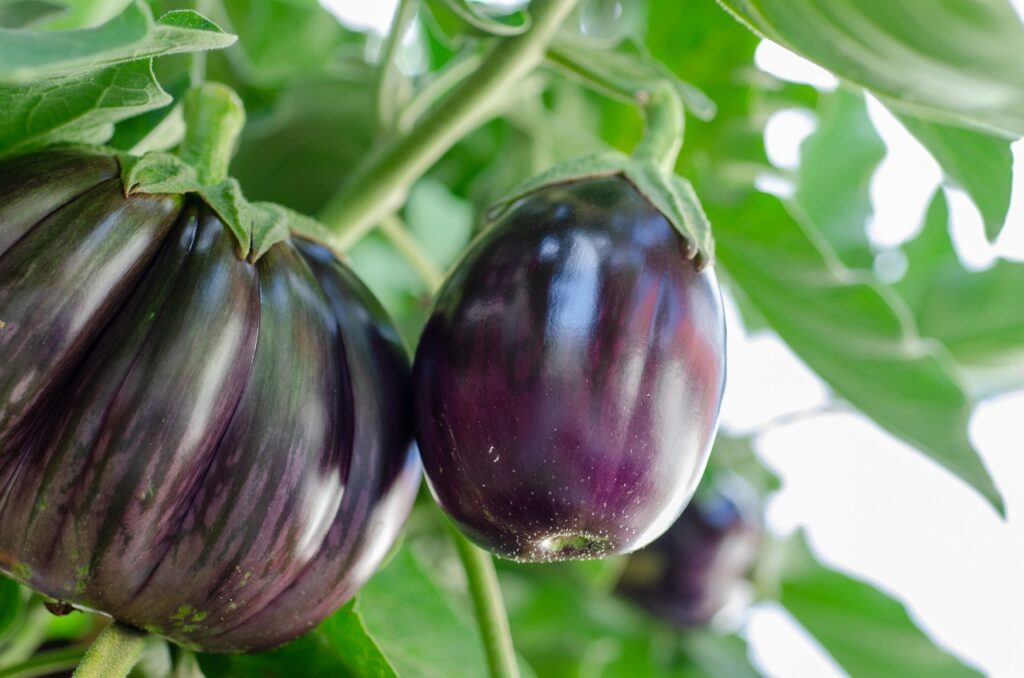
Eggplant (Solanum melongena) is not only a delicious addition to your meals but also brings striking visual interest to your container garden with its glossy purple fruits and lush foliage. Varieties like ‘Black Beauty’ or ‘Fairy Tale’ are compact enough to thrive in containers.
These heat-loving plants prefer full sun and well-drained soil, so choose a pot that allows for good drainage. Regular watering is essential, especially during hot spells, but be careful not to overwater. Fertilize with a balanced fertilizer to support fruit production, and enjoy the vibrant bounty throughout the season.
With these heat-tolerant herbs and vegetables, you can enjoy the satisfaction of growing your own fresh ingredients right on your patio. Their resilience to Florida’s heat ensures that you’ll have a productive and flavorful garden all summer long!
Care Tips for Heat-Tolerant Container Plants in Florida
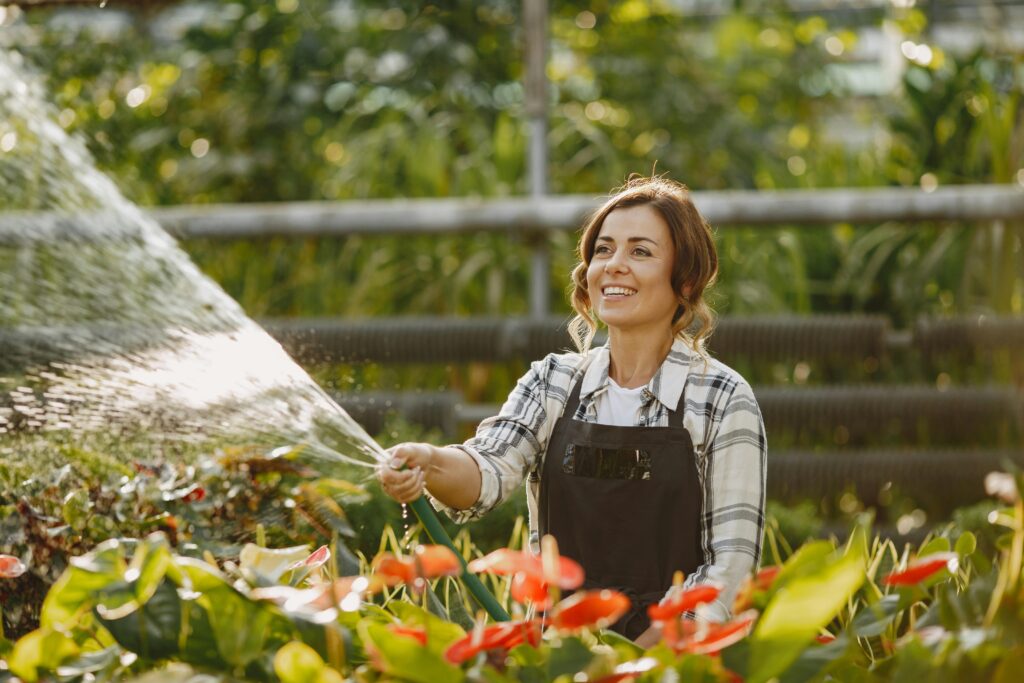
Caring for your heat-tolerant container plants in Florida requires a bit of attention to detail, especially in the summer months. With the right techniques, you can ensure your plants thrive even in the intense heat. Here are some actionable tips to help you keep your garden lush and productive.
Watering Techniques for Hot Weather
Watering your plants effectively is crucial during Florida’s sweltering summers. Here are some techniques to keep in mind:
Early Morning Watering: Aim to water your container plants in the early morning when temperatures are cooler. This allows plants to absorb moisture before the heat of the day sets in, minimizing evaporation.
Deep Watering: Instead of frequent light watering, opt for deep watering sessions. Ensure that water reaches the root zone by saturating the soil until it drains from the bottom of the container. This encourages roots to grow deeper and enhances drought resistance.
Use Drip Irrigation: Consider using a drip irrigation system or self-watering containers. These methods deliver water directly to the roots, reducing water waste and providing a consistent moisture supply.
Proper Fertilization to Support Growth in High Temperatures
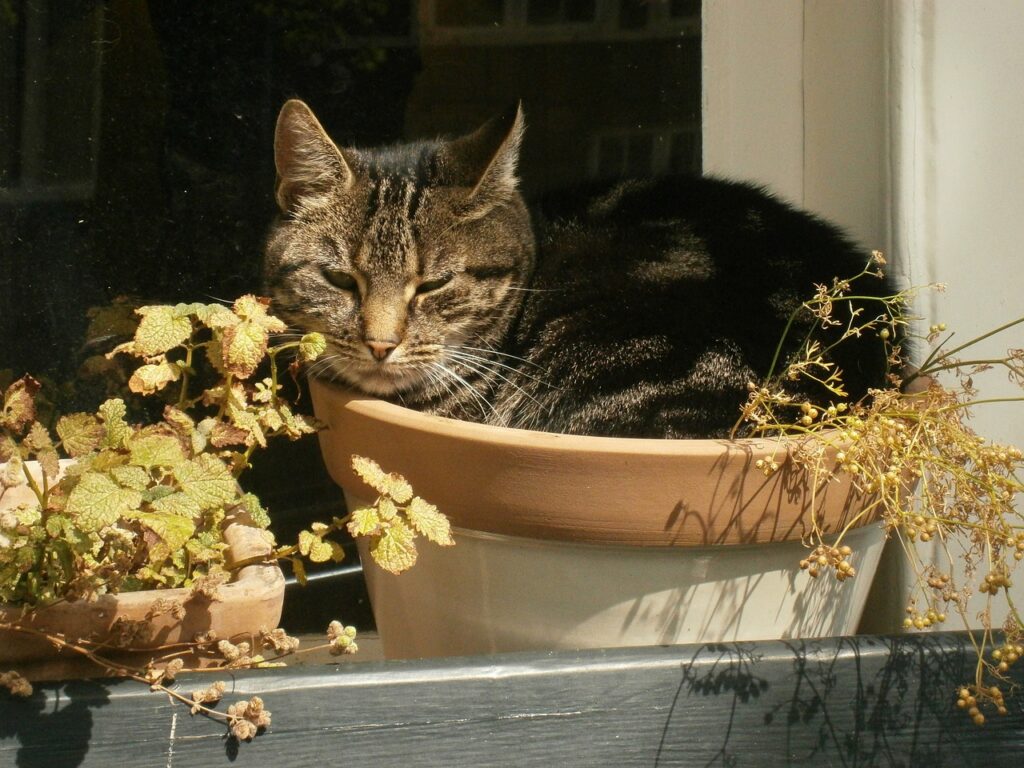
High temperatures can stress plants, making them more susceptible to nutrient deficiencies. Here’s how to properly fertilize:
Slow-Release Fertilizers: Use slow-release fertilizers to provide a steady supply of nutrients throughout the growing season. Look for a balanced formula (like 10-10-10) or one designed for container gardens, and follow the manufacturer’s instructions for application rates.
Liquid Fertilizers: For an immediate nutrient boost, use liquid fertilizers every few weeks during the growing season. Dilute according to the instructions and apply directly to the soil to enhance nutrient uptake.
Monitor Plant Health: Keep an eye on your plants for signs of nutrient deficiency, such as yellowing leaves or stunted growth. Adjust your fertilization schedule as needed based on their appearance.
Mulching to Retain Moisture and Cool Roots
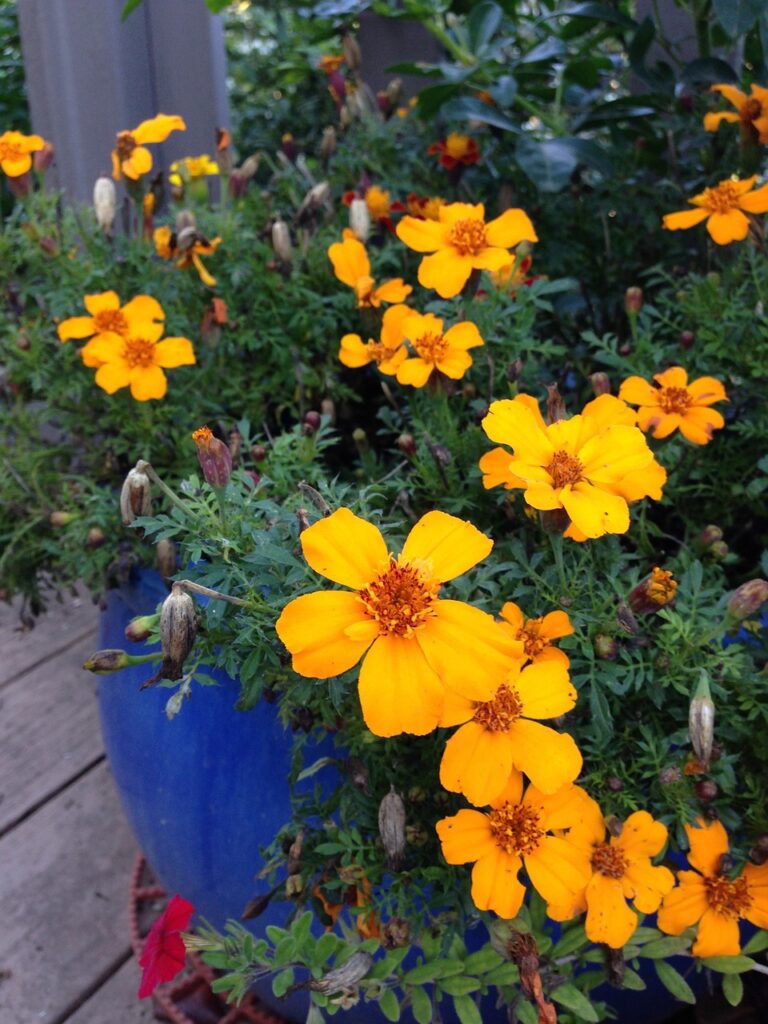
Mulching is an excellent technique for managing soil temperature and moisture levels. Here’s how to do it effectively:
Choose the Right Mulch: Use organic materials like pine bark, straw, or shredded leaves. These materials not only retain moisture but also improve soil structure as they break down.
Apply a 2- to 3-Inch Layer: Spread a 2- to 3-inch layer of mulch on top of the soil in your containers. This will help reduce evaporation, keep the soil cooler, and suppress weeds.
Replenish as Needed: Check your mulch periodically and replenish it as it breaks down to maintain effective moisture retention.
Providing Afternoon Shade for Sensitive Plants
Some plants, even those classified as heat-tolerant, may struggle in full sun during the hottest parts of the day. Here’s how to protect them:
Use Shade Cloth: If you notice your plants wilting or browning, consider using shade cloth to provide some relief. Hang it above your containers to filter sunlight during the afternoon heat.
Strategic Placement: Arrange your containers in a way that taller plants or nearby structures can provide shade to more sensitive varieties. This can help them thrive while still getting the necessary sunlight.
Move Containers: If you have mobile containers, consider moving them into shadier spots during extreme heat periods. Just ensure any relocation is gradual to minimize stress on the plants.
Pruning and Deadheading for Continued Blooms
Regular maintenance through pruning and deadheading can promote healthy growth and blooming. Here’s what to do:
Deadheading Flowers: Remove spent flowers regularly to encourage new blooms. This not only keeps your plants looking tidy but also directs energy back into producing more flowers.
Prune for Shape and Health: Trim back overgrown or leggy plants to maintain a desirable shape and to promote bushier growth. For some plants, pruning back about one-third of the stems can stimulate new growth.
Monitor for Pests: While pruning, check your plants for signs of pests or disease. Early detection is key to managing issues before they spread.
By following these care tips, your heat-tolerant container plants will thrive in Florida’s challenging climate. With proper attention to watering, fertilization, mulching, shading, and maintenance, you’ll enjoy a vibrant and flourishing garden throughout the warm months!
Designing with Heat-Tolerant Plants: Container Combinations That Pop

Designing a stunning container garden with heat-tolerant plants involves creativity and strategic planning. By combining various plants thoughtfully, you can create visually appealing arrangements that thrive in Florida’s sunny climate. Here’s how to design vibrant container combinations that will make your garden stand out.
Creating Height and Depth with Plant Combinations
Layering plants of varying heights not only adds visual interest but also helps maximize space in your containers.
Tall Plants: Start with taller plants like Angelonia or Lantana in the back or center of the container. These will serve as focal points and add vertical interest to your arrangement.
Medium Plants: Include medium-height plants such as Pentas or Gaillardia around the edges to create a soft transition from the tall plants to shorter ones.
Low-Growing Plants: Fill in with low-growing varieties like Purslane or groundcover herbs. These will create a lush, full appearance and help soften the overall look of the container.
Color Schemes That Thrive in Florida’s Bright Sunlight
Choosing the right color scheme can enhance your container garden’s beauty while ensuring the plants flourish.
Warm Colors: Opt for warm colors like reds, oranges, and yellows to create a vibrant, energetic feel. Plants like Marigolds and Zinnias work beautifully here.
Cool Colors: For a calming effect, select cool colors such as blues and purples. Salvia and Calibrachoa are excellent choices that will add depth and contrast.
Contrasting Shades: Consider using contrasting shades to create visual drama. Pairing deep purples of Ti Plants with the bright yellows of Coreopsis can make each color pop.
Mixing Textures for Visual Interest
Combining plants with different textures will add dimension and intrigue to your arrangements.
Broad Leaves vs. Fine Leaves: Mix broad-leaved plants like Croton with fine-leaved herbs like Rosemary. This contrast will catch the eye and create a layered effect.
Succulents and Foliage: Incorporate succulents like Aloe Vera or Echeveria with leafy plants such as Caladiums.Their differing shapes and sizes will enhance the overall texture.
Trailing Plants: Add trailing plants like Lantana or Sweet Potato Vine to spill over the sides of your containers, creating a soft, cascading effect that adds movement and life.
Companion Planting for Pest Control and Mutual Benefits
Incorporating companion planting techniques can enhance plant health and reduce pest issues.
Herbs with Vegetables: Plant Basil alongside Tomatoes to repel pests and improve flavor. The two thrive together and maximize your container’s productivity.
Flowers with Edibles: Add **Marigolds** to your vegetable containers to deter aphids and root-knot nematodes, benefiting both your flowers and vegetables.
Nectar Plants: Include nectar-rich plants like Pentas in your vegetable garden to attract beneficial pollinators that can help with fruit and vegetable production.
Seasonal Rotation Ideas for Year-Round Interest
To keep your container garden looking fresh throughout the year, consider rotating your plants seasonally.
Spring and Summer: Start with heat-tolerant annuals like Zinnias and Cosmos that bloom vibrantly. Add in herbs like Basil and Oregano for both beauty and culinary use.
Fall and Winter: Transition to more resilient plants like Pansies and Snapdragons for cooler months. Adding Kale and Chard not only provides a colorful edible option but also thrives in the lower temperatures.
Mix Seasonal Blooms: Create containers that transition between seasons by mixing perennials like Salvia that will return year after year with seasonal annuals for a dynamic look.
By applying these design strategies, you can create stunning, heat-tolerant container combinations that not only thrive in Florida’s climate but also bring joy and beauty to your outdoor spaces. Happy gardening!
Troubleshooting Common Issues with Heat-Tolerant Plants
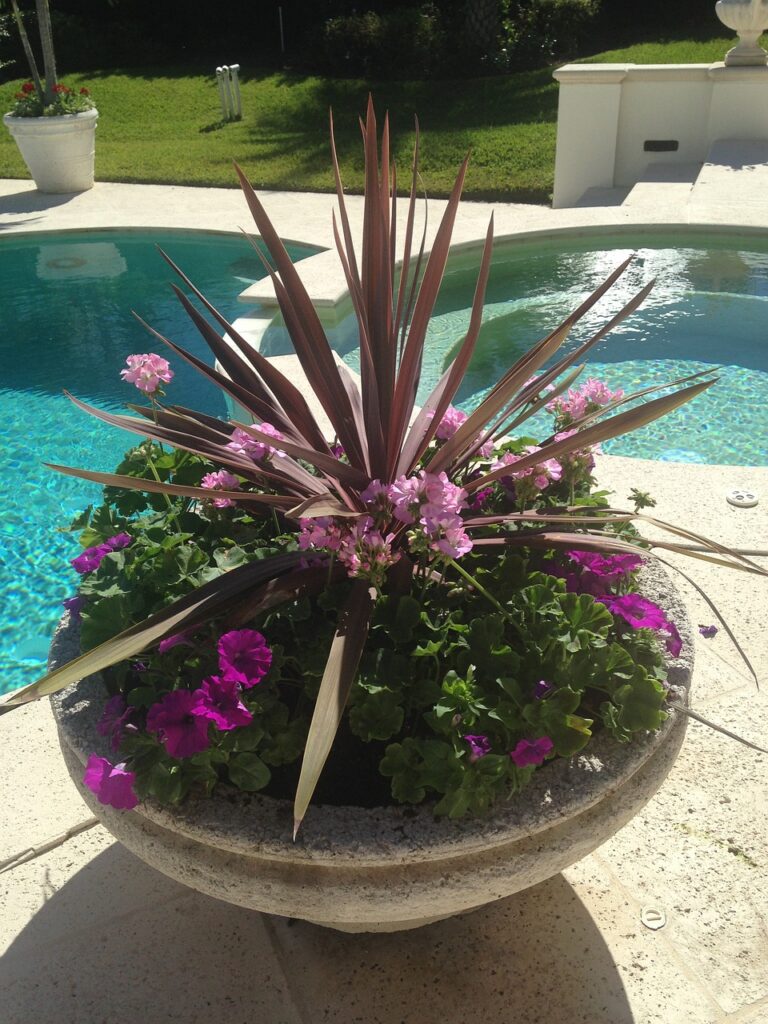
Even the most heat-tolerant plants can face challenges in Florida’s climate. By knowing how to troubleshoot common issues, you can ensure your container garden remains healthy and vibrant all season long. Here’s how to handle various challenges effectively.
Dealing with Sunscald and Leaf Burn
Sunscald and leaf burn occur when plants are exposed to excessive sunlight, leading to unsightly brown patches or crispy edges on leaves. Here’s how to manage it:
Provide Shade: Consider using shade cloth or strategically placing taller plants to offer some protection during the hottest parts of the day. For sensitive plants, providing afternoon shade can help mitigate sunburn.
Acclimatization: Gradually expose newly planted heat-tolerant plants to full sun. Start them in a partially shaded area and slowly increase their sun exposure over a week or two to prevent shock.
Hydration: Ensure your plants are well-watered, as dry soil can exacerbate sunscald. Water deeply in the morning to keep the roots hydrated, especially during heatwaves.
Managing Pests That Thrive in Hot Weather
Hot weather can lead to a rise in pests that target your container plants. Here’s how to keep them at bay:
Regular Monitoring: Check your plants regularly for signs of pests such as aphids, whiteflies, or spider mites. Early detection is key to effective management.
Natural Predators: Attract beneficial insects like ladybugs or lacewings by planting flowers such as Marigolds or Yarrow nearby. These insects help control pest populations naturally.
Organic Treatments: If pests are spotted, use insecticidal soap, Spinosad, or bt as a safe, organic option to control outbreaks. Spray in the early morning or late afternoon to avoid harming beneficial insects.
Preventing Root Rot in Humid Conditions
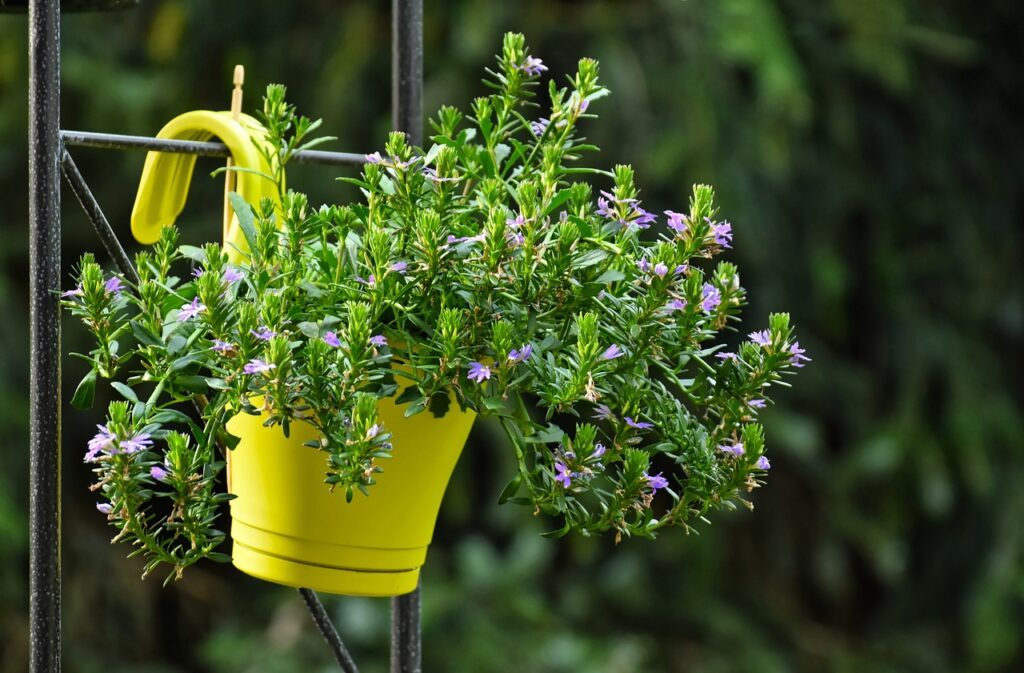
Florida’s humidity can lead to root rot, especially if containers don’t have proper drainage. Here’s how to prevent it:
Choose the Right Containers: Use containers with adequate drainage holes. Consider raised planters or pots made from breathable materials like terra cotta to enhance air circulation.
Soil Mix: Use a well-draining potting mix designed for container gardening. You can create your own by mixing standard potting soil with perlite or coarse sand to improve drainage.
Watering Practices: Avoid overwatering. Ensure the top inch of soil is dry before watering again, and consider using self-watering containers to help regulate moisture levels.
Reviving Wilted Plants During Heatwaves
When extreme heat hits, even heat-tolerant plants can become stressed and wilt. Here’s how to revive them:
Immediate Watering: If you notice wilting, water the plant thoroughly right away. Check the soil moisture level and ensure it’s adequately hydrated.
Mulching: Apply a layer of mulch around the base of the plants. Mulch helps retain soil moisture and keeps roots cool, reducing heat stress.
Temporary Shade: Create temporary shade using a garden umbrella or lightweight fabric to protect plants from intense sunlight until they recover.
Adjusting Care for Sudden Temperature Changes
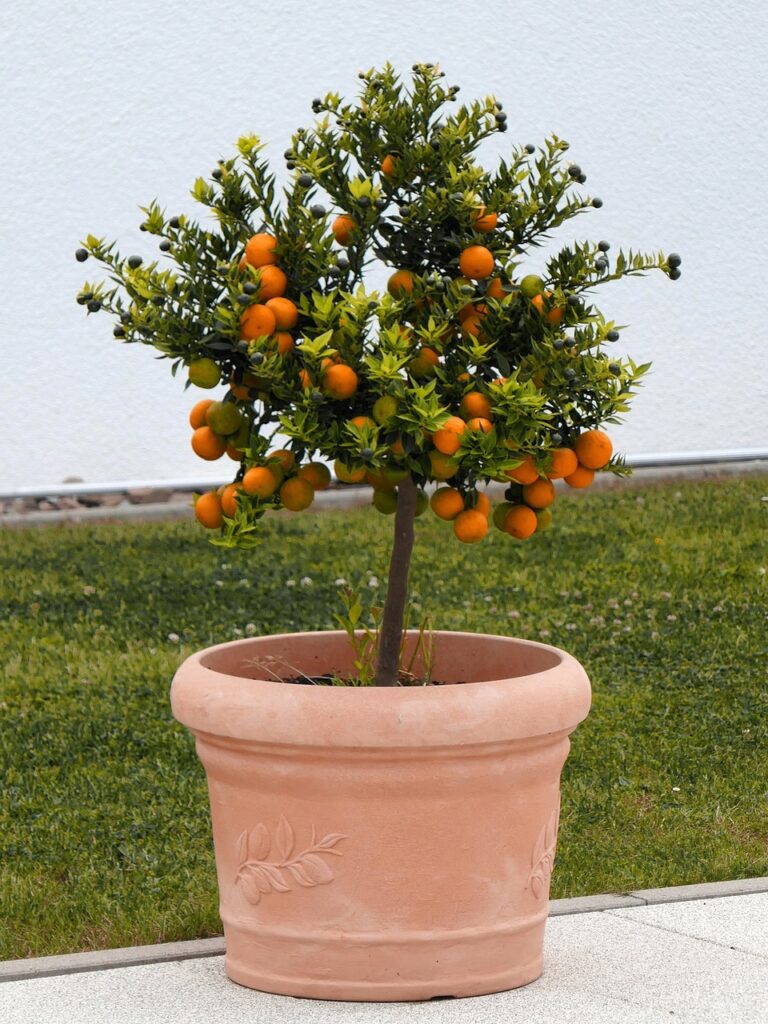
Florida’s weather can be unpredictable, with sudden temperature drops or spikes. Here’s how to adjust your care routine accordingly:
Monitor Weather Conditions: Keep an eye on local forecasts. If a cold snap is expected, move sensitive plants closer together or indoors if possible.
Insulation: For particularly sensitive plants, consider wrapping pots with burlap or using frost cloth to provide insulation against cold temperatures.
Watering Adjustments: Adjust your watering schedule based on temperature changes. In cooler weather, plants may need less water, while hot spells will require more frequent hydration.
By staying proactive and addressing these common issues with heat-tolerant plants, you can maintain a flourishing container garden that stands up to Florida’s unique climate challenges. Happy gardening!
Expanding Your Florida Container Garden: Beyond the Basics
Once you’ve mastered the fundamentals of container gardening in Florida, it’s time to expand your horizons. There are countless opportunities to create a stunning, vibrant garden that not only thrives in the heat but also supports local wildlife and embraces the natural beauty of Florida. Here are some exciting ideas to take your container garden to the next level!
Experimenting with Rare Heat-Tolerant Varieties
Don’t be afraid to think outside the box! Florida’s warm climate allows for the exploration of less common, heat-tolerant plants that can add unique flair to your garden.
Research Uncommon Varieties: Look for rare flowering plants, exotic herbs, or unique vegetable cultivars that can withstand high temperatures. Plants like Mexican Tarragon or Pigeon Pea can be eye-catching and functional.
Visit Local Nurseries: Check out local garden centers or farmers’ markets for unusual plant varieties that are not typically found in big-box stores. The staff can offer advice on what will thrive in your specific conditions.
Creating a Butterfly and Hummingbird Haven
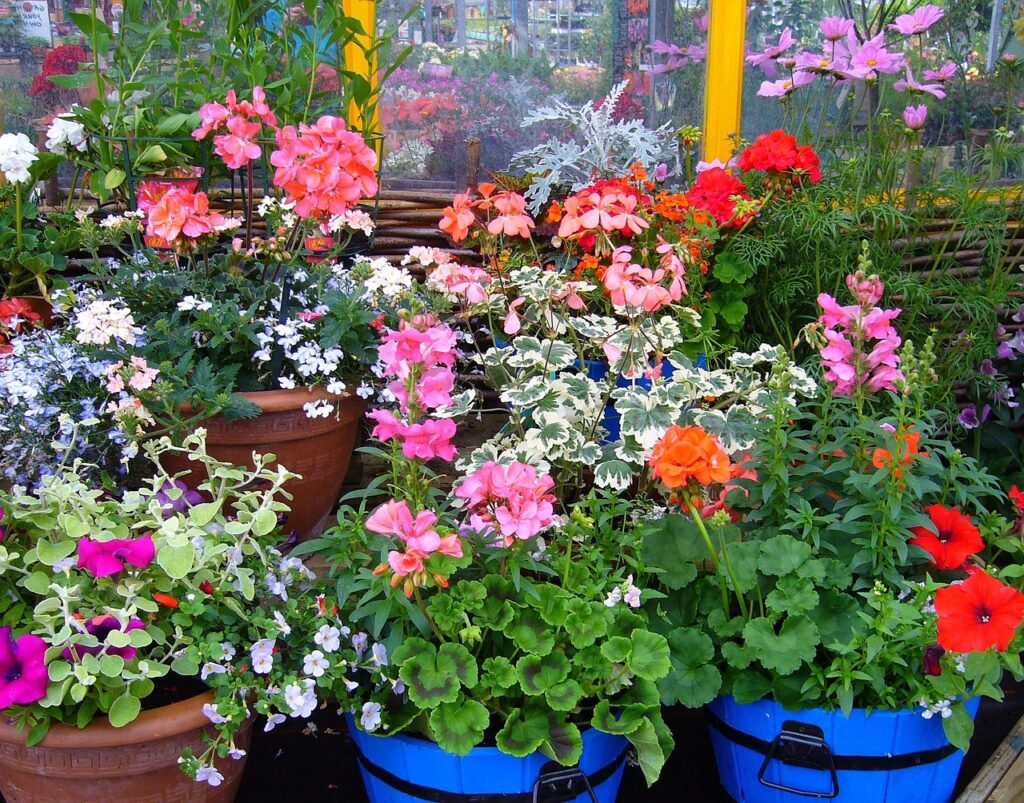
A container garden can be a beautiful sanctuary for butterflies and hummingbirds, enhancing both your outdoor space and local biodiversity.
Select Nectar-Rich Plants: Choose flowering plants that attract these pollinators, such as Native Lantana, Pentas, and Salvia. Group these plants together to create vibrant, inviting spaces.
Add Water Sources: Incorporate shallow dishes filled with water or birdbaths to provide hydration. You can also add pebbles to give butterflies and hummingbirds a safe landing spot.
Create Shelter: Use native plants or decorative elements like small shrubs or grasses to provide shelter for these creatures, making your garden a go-to spot for foraging.
Incorporating Native Florida Plants Into Your Containers
Native plants are an excellent choice for container gardens—they’re adapted to the local climate, require less maintenance, and support local ecosystems.
Select Native Varieties: Explore plants like Florida’s native milkweed, frogfruit, or Coontie. These options are hardy, drought-tolerant, and attract native pollinators.
Promote Biodiversity: By including native species, you can support local wildlife and contribute to the ecological health of your area. Native plants typically require less water and are more resilient against pests and diseases.
Vertical Gardening Ideas for Heat-Tolerant Climbers
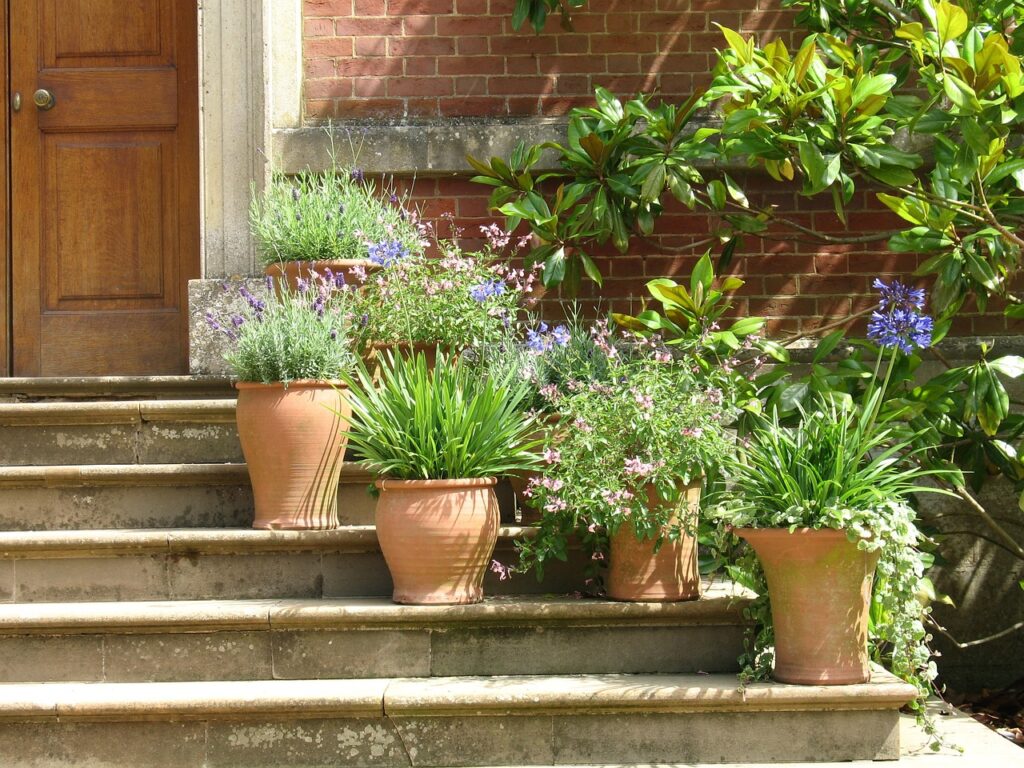
When space is at a premium, vertical gardening is a fantastic solution. It allows you to grow more plants while adding visual interest to your container garden.
Choose Climbing Plants: Select heat-tolerant climbers such as Passionflower, Sweet Potato Vine, or Scarlet Runner Beans. These plants can add height and drama to your garden.
Utilize Trellises and Arches: Incorporate decorative trellises, arbors, or even repurposed fencing to provide support for your climbing plants. Vertical elements can create stunning focal points in your garden.
Hanging Planters: Consider using hanging baskets for trailing varieties, like Trailing Petunias, to create layers of color and texture.
Water-Wise Container Garden Designs for Extreme Heat
In Florida’s intense heat, conserving water while keeping your plants thriving is essential. Here are some design tips to create a water-wise garden:
Use Water-Saving Techniques: Incorporate self-watering containers to help maintain consistent moisture levels, reducing the need for frequent watering.
Select Drought-Resistant Plants: Opt for plants that can withstand dry conditions, like succulents or certain native species. These plants require less water and are perfect for Florida’s hot climate.
Implement Mulching: Add a layer of mulch to your container garden to help retain moisture, regulate soil temperature, and suppress weeds. Organic options like pine straw or shredded bark work well.
Expanding your Florida container garden can be a rewarding and fun journey. By experimenting with diverse plant varieties, attracting wildlife, incorporating native species, utilizing vertical space, and designing for water efficiency, you’ll create a vibrant, thriving garden that brings joy and beauty to your outdoor space. Happy gardening!
The Heat is On
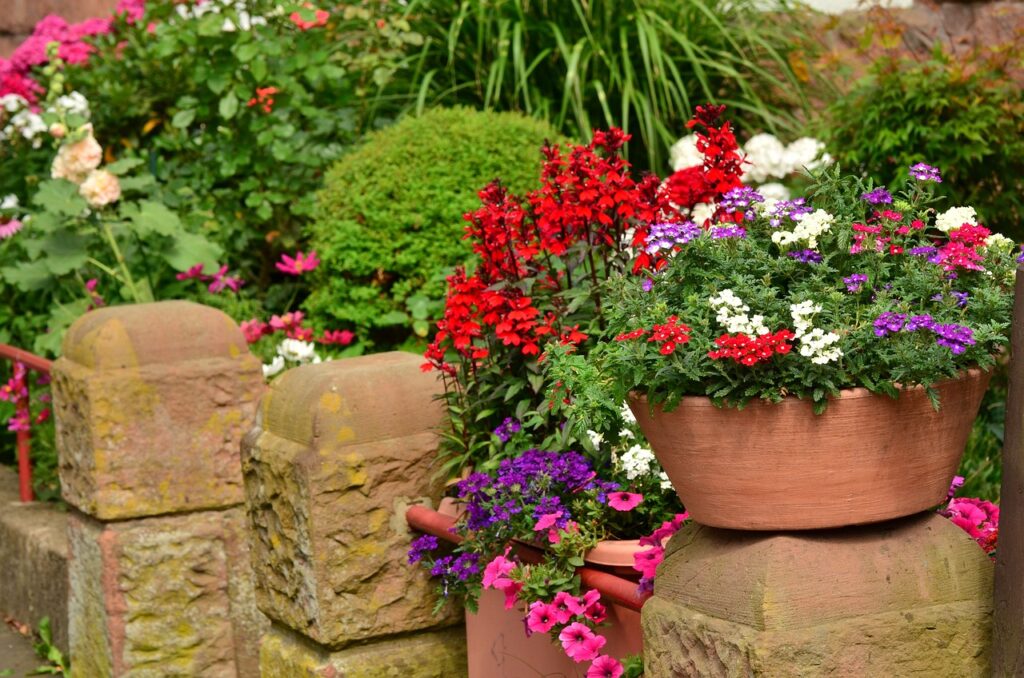
There you have it, fellow Florida gardeners – 15 heat-tolerant plants that’ll turn your container garden into a slice of paradise, no matter how high the mercury rises!
Remember, even these tough plants appreciate a little TLC, so keep them well-watered and show them some love. With this lineup of heat-beating beauties, you’ll be the envy of the neighborhood, enjoying a lush, colorful garden all summer long.
So grab your sunhat, pour yourself a tall glass of iced tea, and get ready to create the Florida container garden of your dreams. Happy gardening, and may your plants always be cooler than you are!



